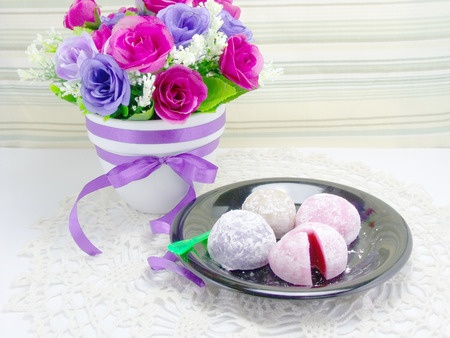
Daifuku Mochi or just Daifuku literally means ‘belly luck’ but in fact most of us will come across it as a famous and traditional Japanese confection or sweet. Daifuku is the main name and mochi refers to the ball of glutinous rice dough which often has a sweet red bean paste filling. It is a really nice dessert when it’s steamed on a cooker or even microwaved. It can also be toasted but has been offered as a present on many ceremonies and is drunk with green tea. A typical composition is 36-40% glutinous rice flour and 36-40% red bean paste.
I rarely see this product outside of London, in fact I have to buy it from a supermarket in Chinatown but of course my Japanese friends have brought it over as a gift.
Japanese sweets are known as wagashi. The red bean paste filling is sweetened with sugar called anko. There are a number of variants of this based on fruit such as strawberry and there are many web-sites which describe a number of recipes that can be tried at home.
Originally, Daifuku was known as Habutai mochi (belly thick rice cake) until the name was changed in the late 18th century. Clearly, the sweet has been around for many centuries.
The mochi is prepared from a very short-grain glutinous rice known as mochigome. Like making Italian pasta, there is a lot of effort needed to prepare the mochi. The glutinous rice must be cooked by steaming and pounded to a smooth paste with wooden mallets called a kine in a Japanese mortar (usu). The modern method now is to do the opposite and mix the raw rice with water where it is pounded and then steamed in a microwave. It makes for a much more dough like product but the basic effect is there. Coating with corn flour helps to keep the balls from sticking to each other.
Mochi is available from a number of retailers because of its versatility in both sweet and savoury dishes. It is often found as dough balls in a Japanese New Year soup called Ozoni or baked with a sour sauce – soy is a good one. Sweet rice does not stay very fresh for long so recooking is meant to bring it back to life although care needs to be taken given the food safety aspects concerned.
Products
This article contains links to our affiliate marketing partner. Please read our affiliate disclosure.
Leave a Reply